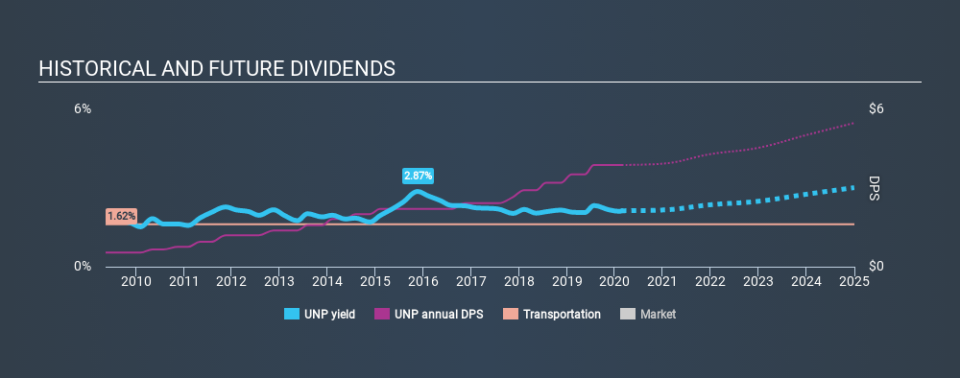Should Income Investors Look At Union Pacific Corporation (NYSE:UNP) Before Its Ex-Dividend?

Readers hoping to buy Union Pacific Corporation (NYSE:UNP) for its dividend will need to make their move shortly, as the stock is about to trade ex-dividend. You can purchase shares before the 27th of February in order to receive the dividend, which the company will pay on the 31st of March.
Union Pacific's next dividend payment will be US$0.97 per share. Last year, in total, the company distributed US$3.88 to shareholders. Looking at the last 12 months of distributions, Union Pacific has a trailing yield of approximately 2.1% on its current stock price of $181.72. We love seeing companies pay a dividend, but it's also important to be sure that laying the golden eggs isn't going to kill our golden goose! That's why we should always check whether the dividend payments appear sustainable, and if the company is growing.
See our latest analysis for Union Pacific
Dividends are typically paid out of company income, so if a company pays out more than it earned, its dividend is usually at a higher risk of being cut. Fortunately Union Pacific's payout ratio is modest, at just 44% of profit. A useful secondary check can be to evaluate whether Union Pacific generated enough free cash flow to afford its dividend. It paid out more than half (50%) of its free cash flow in the past year, which is within an average range for most companies.
It's encouraging to see that the dividend is covered by both profit and cash flow. This generally suggests the dividend is sustainable, as long as earnings don't drop precipitously.
Click here to see the company's payout ratio, plus analyst estimates of its future dividends.
Have Earnings And Dividends Been Growing?
Companies with consistently growing earnings per share generally make the best dividend stocks, as they usually find it easier to grow dividends per share. If earnings fall far enough, the company could be forced to cut its dividend. This is why it's a relief to see Union Pacific earnings per share are up 7.8% per annum over the last five years. While earnings have been growing at a credible rate, the company is paying out a majority of its earnings to shareholders. If management lifts the payout ratio further, we'd take this as a tacit signal that the company's growth prospects are slowing.
The main way most investors will assess a company's dividend prospects is by checking the historical rate of dividend growth. In the last ten years, Union Pacific has lifted its dividend by approximately 22% a year on average. We're glad to see dividends rising alongside earnings over a number of years, which may be a sign the company intends to share the growth with shareholders.
The Bottom Line
Should investors buy Union Pacific for the upcoming dividend? Earnings per share growth has been modest, and it's interesting that Union Pacific is paying out less than half of its earnings and more than half its cash flow to shareholders in the form of dividends. To summarise, Union Pacific looks okay on this analysis, although it doesn't appear a stand-out opportunity.
Ever wonder what the future holds for Union Pacific? See what the 23 analysts we track are forecasting, with this visualisation of its historical and future estimated earnings and cash flow
If you're in the market for dividend stocks, we recommend checking our list of top dividend stocks with a greater than 2% yield and an upcoming dividend.
If you spot an error that warrants correction, please contact the editor at editorial-team@simplywallst.com. This article by Simply Wall St is general in nature. It does not constitute a recommendation to buy or sell any stock, and does not take account of your objectives, or your financial situation. Simply Wall St has no position in the stocks mentioned.
We aim to bring you long-term focused research analysis driven by fundamental data. Note that our analysis may not factor in the latest price-sensitive company announcements or qualitative material. Thank you for reading.

 Yahoo Finance
Yahoo Finance 
